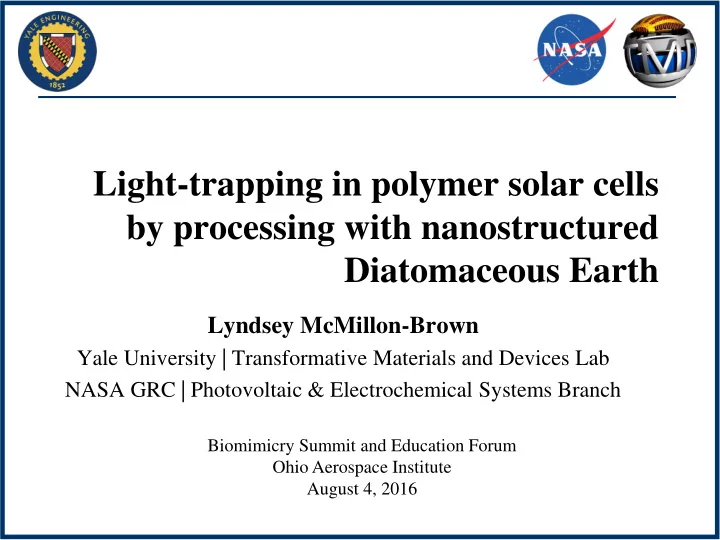

Light-trapping in polymer solar cells by processing with nanostructured Diatomaceous Earth Lyndsey McMillon-Brown Yale University | Transformative Materials and Devices Lab NASA GRC | Photovoltaic & Electrochemical Systems Branch Biomimicry Summit and Education Forum Ohio Aerospace Institute August 4, 2016
Outline • Introduction – Alternative Energy – Solar Cells • Losses in Solar Cells • Solutions to Cell Losses – Biomimetic Approach – Experimental Results – Simulation Results • Future Directions – Design Rules • Conclusions
Alternative Energy
Why solar? • Sunlight is the most abundant source of renewable energy • Solar field the area of Spain can fulfill global energy needs • During operation – No pollution – No emission – No noise
The Solar Cell photon • Converts sunlight directly to electricity • Photon absorbed by E g semiconductor • The electron is excited to the conduction band • Creation of electron- Cathode hole pair Anode Semiconductor
The Solar Cell photon • Converts sunlight directly to electricity • Photon absorbed by semiconductor • The electron is excited to the conduction band • Creation of electron-hole pair • Collection of electrons in cathode • Collection of holes in anode Cathode electrode Anode + + + + Semiconductor electrode - - - - Active Layer
Classes & Applications of Solar Applications • Space Exploration • Defense & Military • Residential Energy • Emergency power • Portable power supplies • Educational • Recreational Options • Organic vs. Inorganic • Single vs. Multi-Junction • Crystalline vs. Amorphous • Flexible vs. Inflexible • Thin Film • Hybrid
Bulk Heterojunction Solar Cells Anode Cathode M. He et al. J. Mater. Chem., 2012, 22 , 24253-24264
Losses in Solar Cells Loss Optical Electrical Unabsorbed Reflection Shadowing Recombination Ohmic Radiation = J SC × OC × h P = P V FF max P P in inc
Light Trapping + • Proposed as early as 1965 - • Increase optical path length Semiconductor Semiconductor material material Rear Reflector Internal Reflection
Light Trapping in Literature Y. Liu, et al. J. Phys. D: Appl. Phys. 46 (2013) 24008 J. Zhao, et al. SOLMAT 42 (1996) 87 • Laser Texturing • Chemical Etching • Nanowires • Nanoholes • Surface Texturing M. Berginski, et al. J. Appl. Phys. 101 (2007) 74903 H. Choi, et al. Nano Lett. 13(5) (2013) 2204
Light Trapping in Nature 20µm 2µm 1µm 1µm W.L. Min, et al. Adv. Mater, 2008, 20 , 3914 Z. Han, et al. Nanoscale, 2012, 4 , 2879-2883 D.G. Stavenga, et al. P. Roy Soc B-Biol Sci, 2006, 273 , 661 Z. Han, et al. Nanoscale, 2013, 5 , 8500-8506
Biomimetic Light Trapping Approach • Diatom Algae • Earth Abundant • 3D Nanostructured silica frustule • Trap light for photosynthesis
Diatomaceous Earth (DE) • Fossilized remains of diatom algae • Photonic Crystal (PhC) • Absorption spectrum matches chlorophyll • Average length ~ 20 um • Active layer thickness ~200 nm L. McMillon-Brown , Marina Mariano, et al. Manuscript in Preparation
Device Fabrication 20 µm 1 mm 1µm L. McMillon-Brown , Marina Mariano, et al. Manuscript in Preparation
Optimal Cell Loading 199± 8 nm 164± 6 nm 128± 3 nm 128± 3 nm DE Addition of DE allows a 36% thinner active layer to achieve comparable PCE to device with standard active layer thickness. L. McMillon-Brown , Marina Mariano, et al. Manuscript in Preparation
Pristine DE as Simulated Light Trap L. McMillon-Brown , Marina Mariano, et al. Manuscript in Preparation
Simulation Results L. McMillon-Brown , Marina Mariano, et al. Manuscript in Preparation
Further Applications of DE • Plasmonic resonators • Patterned electrodes • Anti reflective coatings L. Lu, et al. Nano Lett. 13(1) (2013) 59 S. Chandrasekaran, et al. Chem Commun. 50 (2014) 10441
Design Rules for DE Inspired Solar The frustule or PhC replica: 1. must be applied within active layer to ensure photon absorption results in exciton generation 2. can be implemented in any solution processable solar cell 3. should be positioned in imbedded orientation for optimal device performance
Future Work • Conduct experiments to create design rules for various types of solar modules • Produce and test optimal simulated device • Couple DE inspired PhC with other solar phenomena (plasmonic resonance, FRET) to further enhance device performance
Q: What else can we learn from nature to develop more efficient electronics? Theodor Förster (1910-1974) Image from: Chem. Rev. Soc. (2014), 43 , 588
Acknowledgements • Prof. André D. Taylor, Prof. Barry P. Rand & Prof. Andrey Semichaevsky • Dr. Marina Mariano • Dr. Sara M. Hashmi • YunHui L. Lin • Jinyang Li • Michael F. Piszczor • Dr. Al Hepp • Jeremiah McNatt • Transformative Materials & Devices Lab Members • Photovoltaic & Electrochemical Systems Branch Members • Center for Research on Interface Structures and Phenomena (CRISP) • Yale Institute for Nanoscience and Quantum Engineering (YINQE) • Yale University Rock Preparation Laboratory
Recommend
More recommend